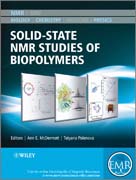
This EMR Book provides an overview of Solid State NMR methods for studying structure dynamics and ligand-binding in biopolymers. Recent developments in pulse sequences for ssNMR studies have allowed a wonderful range of biological systems to be studied in atomic detail. While the field is still growing apace, the collection of pulse sequences has reached a point that an overview and discussion surely warranted. The central core of the volume is an overview of RF pulse sequences for various applications, including not only a systematic catalog but also a discussion of theoretical tools for analysis of pulse sequences. This is supplemented with practical examples of biochemical applications, and detailed discussion of the many aspects of sample preparation and handling that make spectrocopy on solid proteins successful. The structure, conformational dynamics, and the binding of various factors to biopolymers can be probed by Solid State NMR, as has been very recently demonstrated in a number of laboratories. Numerous advances in technology have led to this rapid growth in the field, and the recent developments in pulse sequences has been particularly crucial for developing these capabilities. The popular nature of this topic is principally due to the range of biomedical problems that can be addressed with ssNMR; without need for crystals or monodispersed pure solutions, this method can study quite complex systems, which provides the possibility of very functionally relevant states and very large complexes. Pulse sequences that allow for detailed study of solid and solid-like materials are based on principals that differ substantially from solution NMR or from MRI. Similarly computational tools that allow analysis of the resulting data are a quite specialized area of magnetic resonance. Unlike the other magnetic resonance techniques, ssNMR experiments need to address the anisotropic (i.e. orientation dependent) nature of the interactions and energies (Hamiltonians). Many applications involve magic-angle spinning of samples and therefore the systems are characterized by strictly periodic fluctuations in the Hamiltonians. Coordination of the RF pulsesequences to this periodically varying interaction energy can result in a richly intellectually rewarding area of physical chemistry and spectroscopy, thatis at the same time delightfully practical in problem solving.
- ISBN: 978-0-470-72122-3
- Editorial: John Wiley & Sons
- Encuadernacion: Cartoné
- Páginas: 592
- Fecha Publicación: 13/08/2010
- Nº Volúmenes: 1
- Idioma: Inglés
